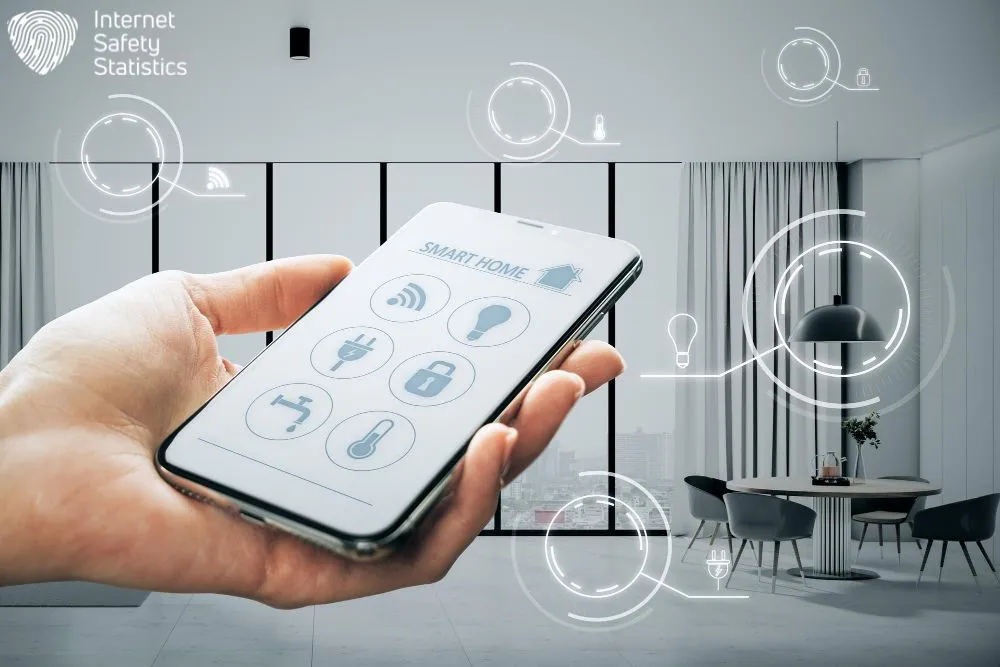
As technology continues to evolve, our homes are evolving with it, transforming into smart, interconnected hubs of innovation and convenience. Yet, as we embrace the era of smart homes powered by the Internet of Things (IoT), we must also confront the complex landscape of cybersecurity. In this blog post, we’ll dive deep into the digital domain, unravelling the intricacies of IoT and its security implications for smart home users. From identifying vulnerabilities to implementing best practices, join us as we navigate the ever-changing frontier of smart home security.
Privacy Concerns and Security Implications for Smart Home Users
Home users face security and privacy concerns with IoT devices due to weak default passwords and vulnerabilities in their devices and networks, leaving them at risk of cyber attacks and personal data breaches.
Weak Default Passwords
Manufacturers often set simple passwords for new IoT devices, thinking it makes setup easier for consumers. However, these predictable passwords create a gaping hole in your home’s cyber defences. Attackers can easily guess or find them online, gaining instant access to your smart home gadgets.
To secure your connected devices, the first step is changing these weak default credentials immediately upon installation. Create strong, unique passwords and update them regularly to prevent unauthorised access that could compromise personal data and network security. This is a fundamental aspect of IoT device security that every user needs to be aware of to protect their digital homes from intrusions and potential threats.
Vulnerabilities in Devices and Networks
Overlooking the significance of strong passwords and user authentication sets up vulnerabilities in devices and networks, making it easier for cyber intruders to gain unauthorised access.
Manufacturers have a responsibility to prioritise security features on IoT devices, safeguarding personal data from potential breaches. Users should be vigilant about monitoring their home network security protocols and protecting against unauthorised access points with regular encryption updates.
The proliferation of smart home devices has created an interconnected web that can potentially expose sensitive personal data if not adequately secured. With the rise of IoT platforms, weak default passwords continue to pose significant risks to privacy and cybersecurity.
The Importance of IoT and its Security Implications
IoT security is crucial for personal safety, protecting against cyber attacks, and safeguarding personal data. With the increasing reliance on IoT devices in homes, it’s essential to prioritise security measures.
Risks to Personal Safety
Protecting personal safety is paramount as IoT devices pose potential risks. Hackers can exploit vulnerabilities in smart home devices to gain access to sensitive information, compromising the safety of individuals and families.
With nearly half of US households expected to use smart home devices by 2026, ensuring robust security measures has never been more critical. Data breaches through IoT devices can lead to identity theft, financial fraud, and invasion of privacy.
As such, it’s imperative for users to stay informed about the latest security threats and actively implement protective measures against these risks.
The Threat of Cyber Attacks
Cyber attacks pose a significant threat to IoT devices and home networks. Hackers can exploit vulnerabilities in smart devices to access sensitive personal data, leaving users at risk of identity theft and financial fraud. With the increase in connected devices, cybercriminals have more entry points into home networks, making it crucial for users to prioritise IoT security measures.
IoT security budgets are on the rise, reflecting the growing recognition of cyber attack threats. The implementation of advanced hardware firewalls and smart home cybersecurity measures has become essential to defend against potential attacks.
Protection of Personal Data
Protect your personal data by securing IoT devices at home. Smart devices can store large amounts of sensitive data, making them a prime target for hackers and cybercriminals. With almost half of UK households expected to use smart home devices by 2026, the need for robust security measures is paramount.
Implementing strong passwords, installing software updates regularly, and using encryption are crucial steps in safeguarding personal information from potential risks and threats.
Ensure the safety of your home networks to protect personal data from unauthorised access. The rise of IoT devices has brought numerous cybersecurity implications, highlighting the importance of securing connected devices within your household.
Current Trends in IoT Security
Advancements in automotive IoT and the slow adoption of IoT technology are shaping the current trends in IoT security. The growth of 5G infrastructure and the implementation of hardware firewalls, as well as an increase in smart home cybersecurity measures, are also notable developments.
Advancements in Automotive IoT
Automotive IoT has seen significant advancements in recent years. These developments include the integration of sensors and connectivity features, allowing vehicles to collect and transmit data for improved safety, maintenance, and overall performance.
The rise of autonomous vehicles is a key area where automotive IoT has made strides, with the use of advanced sensors and AI technologies enabling self-driving capabilities.
The adoption of automotive IoT presents new opportunities but also raises concerns about potential cybersecurity risks such as hacking or unauthorised access to vehicle systems. Understanding these advancements is crucial for individuals seeking to harness the benefits while safeguarding against potential security threats.
Slow Adoption of IoT Technology
Despite the rise in IoT devices, there remains slow adoption of IoT technology among home users. This delay exposes households to potential security risks as connected devices become more prevalent.
As a result, it is imperative for individuals to understand and address the importance of securing their IoT devices promptly. With nearly half of US households projected to use smart home devices by 2026, it is crucial for users to stay informed about the security implications and take proactive measures.
The gradual integration of IoT technology into homes poses significant challenges in ensuring network and device security. However, staying informed about these vulnerabilities can help users safeguard their personal data and protect against potential threats from cybercriminals seeking entry points through connected devices.
Growth of 5G Infrastructure
Although the adoption of IoT technology has been slow, the growth of 5G infrastructure is rapidly changing the landscape. The arrival of 5G promises faster and more reliable wireless connections, unlocking numerous possibilities for smart home devices and other IoT applications.
This development in connectivity brings with it increased data transfer speeds and lower latency, paving the way for expanded usage of IoT devices within homes and workplaces. The deployment of 5G technology not only enhances the performance of existing IoT devices but also enables the introduction of new innovations that depend on high-speed connectivity.
Implementation of Hardware Firewalls
Hardware firewalls are crucial for securing home networks against potential cyber threats. They act as a barrier between connected devices and the internet, monitoring incoming and outgoing traffic to block unauthorised access and malicious content.
By implementing hardware firewalls, users can add an extra layer of defence to protect their IoT devices from cyber attacks and intrusions. With the rise in the adoption of smart home technology, safeguarding personal data through hardware firewalls has become increasingly important.
As more households integrate smart devices into their daily lives, the implementation of hardware firewalls is essential in ensuring the security and privacy of IoT systems. These proactive measures serve as a vital defence mechanism against unauthorised access and potential vulnerabilities in connected devices.
Increase in Smart Home Cybersecurity Measures
Smart home cybersecurity measures are on the rise as more households embrace IoT devices. With almost half of US households expected to use smart home devices by 2026, there is a growing awareness of the need for enhanced security.
The increase in connected devices offers hackers more entry points, prompting the implementation of advanced security measures such as hardware firewalls and strong authentication protocols.
As smart devices can store large amounts of sensitive data, protecting them from potential risks and threats becomes paramount. It’s essential for individuals to secure their IoT devices at home to safeguard personal information and ensure the safety of home networks.
Defending Against IoT Security Threats

Understanding your IoT devices is the first step to defending against security threats. By identifying potential security issues and implementing strong security measures, home users can protect their personal data and privacy.
Understanding IoT Devices
IoT devices, such as smart thermostats and security cameras, are interconnected gadgets that communicate with each other and exchange data over the internet. These devices can be controlled remotely using smartphones or voice commands, providing convenience and automation for various tasks around the home or office.
With the rapid growth of IoT technology, it’s crucial to grasp how these devices function within a network and comprehend their potential vulnerabilities. As households increasingly adopt IoT devices like smart speakers and fitness trackers, understanding the risks associated with these interconnected gadgets becomes fundamental in safeguarding personal data.
As we delve into the intricacies of IoT devices, it’s imperative to acknowledge their widespread usage across homes and businesses alike. Ensuring a clear understanding of how these devices operate within our daily lives is key to implementing effective security measures against potential cyber threats.
Identifying Potential Security Issues
Understanding the types of potential security issues that can affect IoT devices is crucial for home users. Weak default passwords and vulnerabilities in both devices and networks are common concerns that can expose personal data to cyber threats. The increase in connected devices provides hackers with numerous entry points, making it essential for users to be vigilant about protecting their smart home technology.
Home users should stay informed about the latest trends and advancements in IoT security, such as the implementation of hardware firewalls or advanced authentication protocols, in order to defend against potential security threats.
Implementing Security Measures
Secure your IoT devices at home by implementing the following security measures:
- Change default passwords on all your IoT devices, as weak passwords can make them vulnerable to cyber-attacks.
- Regularly update the firmware and software on your devices to fix any known security vulnerabilities.
- Use strong encryption methods for your Wi-Fi network to prevent unauthorised access to your IoT devices.
- Enable two-factor authentication whenever possible to add an extra layer of security to your smart home devices.
- Segment your home network to isolate IoT devices from personal computers and sensitive data, reducing the risk of a breach affecting all connected devices.
- Invest in hardware firewalls and antivirus solutions specifically designed for IoT devices to provide additional protection against malware and other cyber threats.
- Educate yourself and other members of your household about best practices for using and securing IoT devices to ensure everyone understands their role in maintaining a secure smart home environment.
In summary, home users need to understand the security implications of IoT. They should actively evaluate their devices and networks for potential vulnerabilities. Taking proactive steps to secure IoT devices is crucial for safeguarding personal data and ensuring a safe digital environment. Embracing smart home cybersecurity measures can protect against emerging threats in the ever-evolving landscape of IoT technologies.
